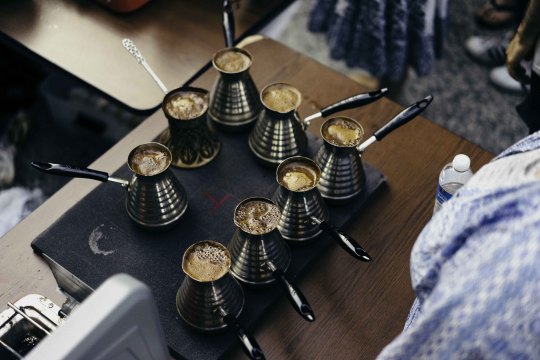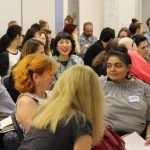Conversations | Aida Šehović’s Nomadic Monument, “ŠTO TE NEMA”
“How do we talk about and heal from genocide? Who are the custodians of our collective history? Can we imagine a world in which deliberate and systematic destruction of whole groups of people does not exist?” – Aida Šehović, Project Director, ŠTO TE NEMA
ŠTO TE NEMA is a nomadic monument led by Aida Šehović that began as a one-time performance in 2006 and has since traveled across the U.S. and Europe to cities including Boston, New York, Stockholm, Geneva, and Istanbul. Each July 11, Šehović brings members of the public together to commemorate Srebrenica Memorial Day and participate in the project by placing fildžani, Bosnian for “cup,” on the ground and filling them with Bosnian coffee throughout the day. The act pays tribute to the 8,372 lives lost in the 1995 Srebrenica Massacre. Starting with 923 donated fildžani, the project now includes over 7,000 donated cups.
Šehović will be holding the 13th ŠTO TE NEMA performance on July 11 in Zurich, Switzerland. Learn about the significance of ŠTO TE NEMA in Šehović’s life as an artist and as a Bosnian Muslim below.
What: ŠTO TE NEMA Nomadic Monument
Where: Helvetia Square, Zurich, Switzerland
When: July 11, 2018, 9:00 AM – 7:00 PM

NYFA: ŠTO TE NEMA is a participatory performance. What does this performance entail and how do each of its iterations differ from one year to the next?
Aida Šehović: ŠTO TE NEMA is collectively assembled and disassembled by people on July 11 each year in a different location in partnership with the Bosnian diaspora and local communities. The monument consists of a growing collection of small porcelain cups (fildžani) donated by Bosnian families from all over the world, so it grows in size every year. The public is invited to participate in making the monument by placing the collected fildžani on the ground and filling them with Bosnian coffee prepared on site throughout the day. Nobody drinks the coffee that’s being poured into cups as this symbolic gesture of serving coffee to someone who is no longer here is meant to memorialize their absence.
NYFA: What has led you to carry on this project for the past 12 years? What do you hope your audience walks away with after participating in ŠTO TE NEMA?
AS: How do we talk about and heal from genocide? Who are the custodians of our collective history? Can we imagine a world in which deliberate and systematic destruction of whole groups of people does not exist? I continue to make this work to remind us that any genocide is a crime against humanity, and therefore a crime against all of us. I urge us to resist the implicit acceptance that we have no agency, and I want to amplify that by coming together in empathy and solidarity in a public space, we are an antidote to the very purpose of genocide.
NYFA: Your first ŠTO TE NEMA nomadic monument took place in 2006 with 923 donated fildžani and there are now over 7,000 donated cups. What is the significance of using fildžani? What does the fildžani represent?
AS: The first 923 fildžani were collected and donated by “Women of Srebrenica”—an organization founded by women whose husbands, sons, brothers, fathers, and other male relatives were killed in July of 1995. More than 20 years later, some of them still do not have closure as they continue to search for the remains of their loved ones so that they can bury them. Each donated fildžani symbolically represents one of the 8,372 victims of the Srebrenica genocide.

NYFA: Since its creation, ŠTO TE NEMA has been showcased in various countries in collaboration with Bosnian diaspora communities across the U.S. and Europe. How do you map out these Bosnian diaspora communities?
AS: While I initiated the first iteration of the monument in 2006, ŠTO TE NEMA has traveled to 12 different U.S. and European cities to date upon invitation.This interest and commitment by Bosnian immigrant communities to bring the monument to their adopted hometowns is crucial since ŠTO TE NEMA is intentionally designed so that it cannot exist without involvement and the contributions of others. By bringing together survivors and those directly or indirectly affected by genocide, I hope that the imposed dichotomy of “us vs. them” disintegrates, and that ŠTO TE NEMA builds a more resilient and inclusive society wherever it travels to.
NYFA: You joined NYFA Fiscal Sponsorship in 2016. Why did you join at this phase in your project and why NYFA?
AS: When I began ŠTO TE NEMA in 2006, I had no idea that this one-time performance would become a recurring monument that travels all over the world. But as the project continued and more people got involved, it became clear that the grassroots model was no longer enough to sustain an ongoing project of this scale that engages so many communities. NYFA Fiscal Sponsorship was a crucial step in steering ŠTO TE NEMA to its fullest potential as an artist-led yet community-driven international public art project.
NYFA: What significance has ŠTO TE NEMA had on your practice as an artist?
AS: I am an artist because I believe that art has the power to change the world. I was lucky enough to experience how powerful art can be during the first iteration of ŠTO TE NEMA when I witnessed its impact on people thirteen years ago. Over the years, this project has profoundly influenced how I think about art today, but it also continuously reaffirms that I am mostly interested in making art collectively with others, and not alone in the studio. In the meantime, ŠTO TE NEMA has grown so much that it no longer feels like a choice, but a responsibility. I am now a caretaker of a nomadic monument that keeps evolving.
– Interview conducted by Eleysha Sajous, Fiscal Sponsorship Intern
Are you an artist or new organization, and interested in increasing your fundraising opportunities through NYFA Fiscal Sponsorship? No-fee applications are accepted on a quarterly basis and our upcoming September deadline is around the corner. We also accept Out-of-Cycle Reviews year-round. Click here to learn more about the program and to apply. Sign up for our free bi-weekly newsletter, NYFA News, for the latest updates and news about Sponsored Projects and Emerging Organizations.
Images: 10th ŠTO TE NEMA Nomadic Monument at Place de Saint Gervais, Geneva, Switzerland, 2017, Photo Credit: Carlos Serra; 12th ŠTO TE NEMA Nomadic Monument at Daley Plaza, Chicago, 2017, Photo Credit: Manka Rabiye; 12th ŠTO TE NEMA Nomadic Monument at Daley Plaza, Chicago, 2017, Photo Credit: Leonard Correa. All Images Courtesy: Aida Šehović.





